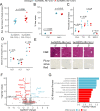Hepatic inactivation of murine Surf4 results in marked reduction in plasma cholesterol
- PMID: 36193893
- PMCID: PMC9581532
- DOI: 10.7554/eLife.82269
Hepatic inactivation of murine Surf4 results in marked reduction in plasma cholesterol
Abstract
PCSK9 negatively regulates low-density lipoprotein receptor (LDLR) abundance on the cell surface, leading to decreased hepatic clearance of LDL particles and increased levels of plasma cholesterol. We previously identified SURF4 as a cargo receptor that facilitates PCSK9 secretion in HEK293T cells (Emmer et al., 2018). Here, we generated hepatic SURF4-deficient mice (Surf4fl/fl Alb-Cre+) to investigate the physiologic role of SURF4 in vivo. Surf4fl/fl Alb-Cre+ mice exhibited normal viability, gross development, and fertility. Plasma PCSK9 levels were reduced by ~60% in Surf4fl/fl Alb-Cre+ mice, with a corresponding ~50% increase in steady state LDLR protein abundance in the liver, consistent with SURF4 functioning as a cargo receptor for PCSK9. Surprisingly, these mice exhibited a marked reduction in plasma cholesterol and triglyceride levels out of proportion to the partial increase in hepatic LDLR abundance. Detailed characterization of lipoprotein metabolism in these mice instead revealed a severe defect in hepatic lipoprotein secretion, consistent with prior reports of SURF4 also promoting the secretion of apolipoprotein B (APOB). Despite a small increase in liver mass and lipid content, histologic evaluation revealed no evidence of steatohepatitis or fibrosis in Surf4fl/fl Alb-Cre+ mice. Acute depletion of hepatic SURF4 by CRISPR/Cas9 or liver-targeted siRNA in adult mice confirms these findings. Together, these data support the physiologic significance of SURF4 in the hepatic secretion of PCSK9 and APOB-containing lipoproteins and its potential as a therapeutic target in atherosclerotic cardiovascular diseases.
Keywords: APOB; PCSK9; SURF4; cell biology; cholesterol; mouse; secretion.
© 2022, Tang et al.
Conflict of interest statement
VT, JM, BX, YW, HF, XW, DS, RK, BE, XC, DG No competing interests declared
Figures











References
-
- Benjannet S, Rhainds D, Essalmani R, Mayne J, Wickham L, Jin W, Asselin MC, Hamelin J, Varret M, Allard D, Trillard M, Abifadel M, Tebon A, Attie AD, Rader DJ, Boileau C, Brissette L, Chrétien M, Prat A, Seidah NG. NARC-1/PCSK9 and its natural mutants: zymogen cleavage and effects on the low density lipoprotein (LDL) receptor and LDL cholesterol. The Journal of Biological Chemistry. 2004;279:48865–48875. doi: 10.1074/jbc.M409699200. - DOI - PubMed
Publication types
MeSH terms
Substances
Associated data
- Actions
Grants and funding
LinkOut - more resources
Full Text Sources
Molecular Biology Databases
Miscellaneous

